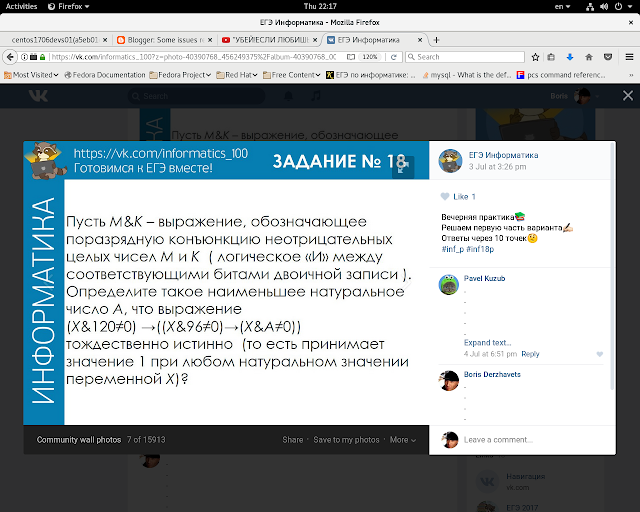(x&120 != 0) => (┐(x&96 !=0) v (x&A !=0))
┐(x&120 != 0) v (┐(x&96 !=0) v (x&A !=0))
( ┐(x&120 != 0) v (┐(x&96 !=0)) v (x&A !=0)
Analyze when ( ┐(x&120 != 0) v (┐(x&96 !=0)) is False
┐(x&120 != 0) = False (1)
┐(x&96 !=0) = False (2)
(x&120 != 0) = True
(x&96 !=0) = True
120 = 1111000 ( binary)
96 = 1100000 (binary)
Let's say that x is called jeopardizing if it makes
┐(x&120 != 0) = False (1)
┐(x&96! = 0) = False (2)
Thus
1 1 1 1 0 0 0 = 120 (decimal)
x
x7x6x5x4x3x2x1
shouldn't be 0
1 1 0 0 0 0 0 =96 (decimal)
x
x7x6x5x4x3x2x1
shouldn't be 0
Consider jeopardizing bits in 120 and 96
So for first equation { x7,x6,x5,x4 } should have at least one bit equal 1
for second equation { x7,x6 } should have at least one bit equal 1
The minimal A (96) should have x7=1 x6=1 due to jeopardizing
x might have 1 on position x7 or x6 and another 0.
First condition would also be satisfied when
x=11***** (binary) where "*' may be 1 or 0.
or
x=01*****(binary)
or
x=10***** (binary)
if x7 and x6 are both equal 0 then
1 1 0 0 0 0 0 =96 (decimal)
x
x7x6x5x4x3x2x1
would be equal 0. What breaks condition (2)
So we must defend by 1 any of two first positions in number A
and filed the rest positions with 0 to minimize A.
Thus A= 1100000 (binary) = 96 (decimal)
I believe we are done with task 18
*************************
Another task
*************************
(x&120 != 0) => ((x&96 =0) => (x&A !=0))
Proceed as follows :-
(x&120 != 0) => (┐(x&96 =0) v (x&A !=0))
┐(x&120 != 0) v (┐(x&96 =0) v (x&A !=0))
( ┐(x&120 != 0) v (┐(x&96 =0)) v (x&A !=0)
Analyze when ( ┐(x&120 != 0) v (┐(x&96=0)) is False
┐(x&120 != 0) = False (1)
┐(x&96 =0) = False (2)
(x&120 != 0) = True
(x&96 =0) = True
120 = 1111000 ( binary)
96 = 1100000 (binary)
Let's say that x is called jeopardizing if it makes
┐(x&120 != 0) = False (1)
┐(x&96 = 0) = False (2)
Thus
1 1 1 1 0 0 0 = 120 (decimal)
x
x7x6x5x4x3x2x1
shouldn't be 0
1 1 0 0 0 0 0 = 96 (decimal)
x
x7x6x5x4x3x2x1
should be 0
Thus for any of jeopardizing x we should have (x&A != 0), otherwise we don't
have any problem because at least one of (1) or (2) is True
Consider jeopardizing bits in 120 and 96
So for first equation { x7,x6,x5,x4 } should have at least one bit equal 1
for second equation { x7,x6 } should have x7=0 and x6=0
So A=0011000 = 11000 (binary) = 24 (decimal)




No comments:
Post a Comment